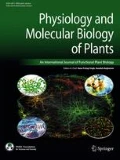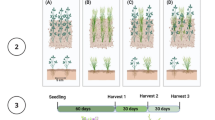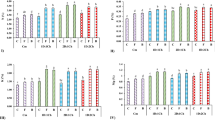Abstract
Due to the low quality of water resources in arid and semi-arid regions of the world, selection and management of forage plants suitable for saline condition is of great importance. Intercropping systems with halophyte plants not only improve production efficiency but also reduce soil salinity. In this study, the effects of different levels of irrigation water salinity and intercropping system on physiological indices and biological yield of Kochia, Guar and Sesbania were investigated during the growing seasons of 2016 and 2017. A split plot experiment was conducted in a randomized complete block design with three replications. The main factor was salinity of irrigation water (4, 9 and 14 dS m−1) and the sub-factor was different cropping systems that consisted of mono cropping of Guar, Sesbania or Kochia, intercropping of two species and intercropping of three species. Results showed that salt stress increased sodium in the leaves of Kochia, Guar and Sesbania. Compared to mono cropping of Guar, in intercropping of three species and in intercropping with Kochia, Guar leaf potassium content was increased by 33.3% and 19.9% respectively. Salinity levels of 9 and 14 dS m−1 compared to salinity level of 4 dS m−1 increased the soluble sugar content of Kochia plant by 65.7% and 52.7%, respectively. However, in similar salinity levels, the trend for soluble sugar changes in Guar was vice versa. Salinity treatment of 14 dS m−1 decreased the relative water content of Sasbania and Guar leaves, but had a reverse effect on Kochia. Intercropping of two and three species also increased the relative water content of Sasbania and Guar leaves. Enhancement in salinity stress increased ionic leakage and malondialdehyde content of Guar leaf. On the other hand, at salinity level of 14 dS m−1, intercropping of three species increased the carotenoid content and decreased the amount of Guar leaf malondialdehyde compared to the Guar mono cropping system. The results of this study showed that salinity stress had negative effect on Guar yield but intercropping with Kochia could partly improve the yield of both Guar and Sesbania. In addition Kochia showed relatively good yield potential under salinity stress. Therefore, to improve the production of Sesbian and Guar, and also physiological performance of Kochia, intercropping system of these plants is recommended under salinity stress conditions.

Similar content being viewed by others
References
Armstrong KL, Albrecht KA, Lauer JG, Riday H (2008) Intercropping corn with lablab bean, velvet bean, and scarlet runner bean for forage. Crop Sci 48(1):371–379
Arnon DI (1949) Copper enzymes in isolated chloroplasts. Polyphenoloxidase in Beta vulgaris. Plant Physiol 24(1):1
Attarzadeh M, Balouchi H, Rajaie M, Dehnavi MM, Salehi A (2019) Improvement of Echinacea purpurea performance by integration of phosphorus with soil microorganisms under different irrigation regimes. Agric Water Manag 221:238–247
Ayala A, Muñoz MF, Argüelles S (2014) Lipid peroxidation: production, metabolism, and signaling mechanisms of malondialdehyde and 4-Hydroxy-2-Nonenal. Oxidative Med Cell Longevity 2014:1–31
Cheeseman JM (2013) The integration of activity in saline environments: problems and perspectives. Funct Plant Biol 40(9):759–774
Deka K, Das MR, Bora P, Mazumder N (2015) Effect of sowing dates and spacing on growth and yield of cluster bean (Cyamopsis tetragonoloba) in subtropical climate of Assam, India. Indian J Agric Res 49(3):250–254
Dhanapackiam S, Ilyas M (2010) Effect of salinity on chlorophyll and carbohydrate contents of Sesbania grandiflora seedlings. Indian J Sci Technol 3(1):64–66
Ferreira-Silva SL, Silveira JA, Voigt EL, Soares LS, Viégas RA (2008) Changes in physiological indicators associated with salt tolerance in two contrasting cashew rootstocks. Braz J Plant Physiol 20(1):51–59
Firoozabadi A, Kazemeini S, Pirasteh-Anosheh H (2017) Evaluation of different planting ratio of sorghum-kochia intercropping in varied salinity conditions. Iran J Range Desert Res 24(3):685–698
Flowers TJ, Munns R, Colmer TD (2015) Sodium chloride toxicity and the cellular basis of salt tolerance in halophytes. Ann Bot 115(3):419–431
García‐Caparrós P, Hasanuzzaman M, Lao MT (2019) Oxidative stress and antioxidant defense in plants under salinity. In: Hasanuzzaman M, Fotopoulos V, Nahar K, Fujita M (eds) Reactive oxygen, nitrogen and sulfur species in plants. https://doi.org/10.1002/9781119468677.ch12
Hameed A, Hussain T, Gulzar S, Aziz I, Gul B, Khan MA (2012) Salt tolerance of a cash crop halophyte Suaeda fruticosa: biochemical responses to salt and exogenous chemical treatments. Acta Physiol Plant 34(6):2331–2340
Houshmand S, Arzani A, Maibody SAM, Feizi M (2005) Evaluation of salt-tolerant genotypes of durum wheat derived from in vitro and field experiments. Field Crops Res 91(2–3):345–354
Irigoyen J, Einerich D, Sánchez-Díaz M (1992) Water stress induced changes in concentrations of proline and total soluble sugars in nodulated alfalfa (Medicago sativd) plants. Physiol Plant 84(1):55–60
Jiménez-Becker S, Ramírez M, Plaza BM (2019) The influence of salinity on the vegetative growth, osmolytes and chloride concentration of four halophytic species. J Plant Nutr 42(15):1838–1849
Kafi M, Salehi M (2019) Potentially domesticable chenopodiaceae halophytes of Iran. In: Gul B, Böer B, Khan MA, Clüsener-Godt M, Hameed A (eds) Sabkha ecosystems: Volume VI: Asia/Pacific. Springer International Publishing, Cham, pp 269–288
Kafi M, Asadi H, Ganjeali A (2010) Possible utilization of high-salinity waters and application of low amounts of water for production of the halophyte Kochia scoparia as alternative fodder in saline agroecosystems. Agric Water Manag 97(1):139–147
Karadge B, Chavan PD (1983) Physiological studies in salinity tolerance ofSesbania aculeata POIR. Biol Plant 25(6):412–418
Kauser, R., Athar, H.-U.-R. & Ashraf, M. (2006). Chlorophyll fluorescence: a potential indicator for rapid assessment of water stress tolerance in canola (Brassica napus L.). Pakistan Journal of Botany 38(5 SPEC. ISS.): 1501–1509
Kumar S, Singh R, Kadian V (2006) Response of dhaincha (Sesbania aculeata) genotypes to sowing dates and row spacing, Indian. J Agron 51(2):152–153
Kurdali F, Janat M, Khalifa K (2003) Growth and nitrogen fixation and uptake in Dhaincha/Sorghum intercropping system under saline and non-saline conditions. Commun Soil Sci Plant Anal 34(17–18):2471–2494
Liang W, Ma X, Wan P, Liu L (2018) Plant salt-tolerance mechanism: a review. Biochem Biophys Res Commun 495(1):286–291
Lithourgidis A, Dhima K, Vasilakoglou I, Dordas C, Yiakoulaki M (2007) Sustainable production of barley and wheat by intercropping common vetch. Agron Sustain Dev 27(2):95–99
Liu Z, Zhu J, Yang X, Wu H, Wei Q, Wei H, Zhang H (2018) Growth performance, organ-level ionic relations and organic osmoregulation of Elaeagnus angustifolia in response to salt stress. PLoS ONE 13(1):e0191552. https://doi.org/10.1371/journal.pone.0191552
Masters DG, Benes SE, Norman HC (2007) Biosaline agriculture for forage and livestock production. Agric Ecosyst Environ 119(3–4):234–248
McKay H (1992) Electrolyte leakage from fine roots of conifer seedlings: a rapid index of plant vitality following cold storage. Can J For Res 22(9):1371–1377
Muchate NS, Nikalje GC, Rajurkar NS, Suprasanna P, Nikam TD (2016) Plant salt stress: adaptive responses, tolerance mechanism and bioengineering for salt tolerance. Bot Rev 82(4):371–406
Negrão S, Schmöckel S, Tester M (2017) Evaluating physiological responses of plants to salinity stress. Ann Bot 119(1):1–11
Panta S, Flowers T, Doyle R, Lane P, Haros G, Shabala S (2018) Temporal changes in soil properties and physiological characteristics of Atriplex species and Medicago arborea grown in different soil types under saline irrigation. Plant Soil 432(1–2):315–331
Paquin R, Lechasseur P (1979) Observations sur une méthode de dosage de la proline libre dans les extraits de plantes. Can J Bot 57(18):1851–1854
Patterson BD, MacRae EA, Ferguson IB (1984) Estimation of hydrogen peroxide in plant extracts using titanium (IV). Anal Biochem 139(2):487–492
Ritchie SW, Nguyen HT, Holaday AS (1990) Leaf water content and gas-exchange parameters of two wheat genotypes differing in drought resistance. Crop Sci 30(1):105–111
Salehi M, Kafi M, Kiani A (2009) Growth analysis of kochia (Kochia scoparia (L.) schrad) irrigated with saline water in summer cropping. Pak J Bot 41(4):1861–1870
Sardo V (2005) Halophytes and salt-tolerant glycophytes a potential resource. The Use of Nonconventional Water Resources. CIHEAM/EU DG Research, Bari 8
Sekar J, Saharan K, Raju K, Singh U, Vaiyapuri PR (2019) Consequences of bioinoculants and intercropping approach to alleviate plant drought and salinity stress for sustainable agriculture. In: Akhtar MS (ed) Salt stress, microbes, and plant interactions: mechanisms and molecular approaches, Vol 2. Springer Singapore, Singapore, pp 161–182
Seki M, Umezawa T, Urano K, Shinozaki K (2007) Regulatory metabolic networks in drought stress responses. Curr Opin Plant Biol 10(3):296–302
Shannon MC (1997) Adaptation of plants to salinity. Adv Agron 60:75–120
Sharma A, Shahzad B, Kumar V, Kohli SK, Sidhu GPS, Bali AS, Handa N, Kapoor D, Bhardwaj R, Zheng B (2019) Phytohormones regulate accumulation of osmolytes under abiotic stress. Biomolecules 9(7):285
Simpson CR, Franco JG, King SR, Volder A (2018) Intercropping halophytes to mitigate salinity stress in watermelon. Sustainability 10(3):681
Singla S, Grover K, Angadi SV, Begna SH, Schutte B, Van Leeuwen D (2016) Growth and yield of guar (Cyamopsis tetragonoloba L.) genotypes under different planting dates in the semi-arid Southern High Plains. Am J Plant Sci 7(8):1246–1258
Slama I, Abdelly C, Bouchereau A, Flowers T, Savoure A (2015) Diversity, distribution and roles of osmoprotective compounds accumulated in halophytes under abiotic stress. Ann Bot 115(3):433–447
Valentovic P, Luxova M, Kolarovic L, Gasparikova O (2006) Effect of osmotic stress on compatible solutes content, membrane stability and water relations in two maize cultivars. Plant Soil and Environment 52(4):184
Wang L, Liu J, Wang W, Sun Y (2016) Exogenous melatonin improves growth and photosynthetic capacity of cucumber under salinity-induced stress. Photosynthetica 54(1):19–27
Yadav SP, Bharadwaj R, Nayak H, Mahto R, Singh RK, Prasad SK (2019) Impact of salt stress on growth, productivity and physicochemical properties of plants: a Review. Int J Comp Sociol 7:1793–1798
Yang F, Liao D, Wu X, Gao R, Fan Y, Raza MA, Wang X, Yong T, Liu W, Liu J (2017) Effect of aboveground and belowground interactions on the intercrop yields in maize-soybean relay intercropping systems. Field Crops Research 203:16–23
Zörb C, Geilfus CM, Dietz KJ (2019) Salinity and crop yield. Plant biology 21:31–38
ZuccaRini P (2008) Ion uptake by halophytic plants to mitigate saline stress in Solanum lycopersicon L., and different effect of soil and water salinity. Soil Water Res 3(2):62–73
Acknowledgements
We thank the Iranian Soil and Water Research Institute and the National Salinity Research Center Iran-Yazd for their generous support in conducting this study.
Author information
Authors and Affiliations
Corresponding author
Additional information
Publisher's Note
Springer Nature remains neutral with regard to jurisdictional claims in published maps and institutional affiliations.
Rights and permissions
About this article
Cite this article
Ghaffarian, M.R., Yadavi, A., Movahhedi Dehnavi, M. et al. Improvement of physiological indices and biological yield by intercropping of Kochia (Kochia scoparia), Sesbania (Sesbania aculeata) and Guar (Cyamopsis tetragonoliba) under the salinity stress of irrigation water. Physiol Mol Biol Plants 26, 1319–1330 (2020). https://doi.org/10.1007/s12298-020-00833-y
Received:
Revised:
Accepted:
Published:
Issue Date:
DOI: https://doi.org/10.1007/s12298-020-00833-y




